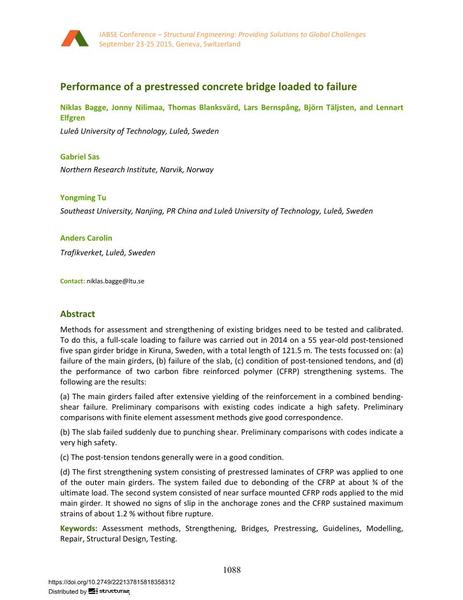Performance of a prestressed concrete bridge loaded to failure

|
|
|||||||||||
Bibliographic Details
| Author(s): |
Niklas Bagge
Jonny Nilimaa (Luleå University of Technology, Luleå, Sweden) Thomas Blanksvärd (Luleå University of Technology, Luleå, Sweden) Lars Bernspång (Luleå University of Technology, Luleå, Sweden) Björn Täljsten (Luleå University of Technology, Luleå, Sweden) Lennart Elfgren Gabriel Sas (Northern Research Institute, Narvik, Norway) Yongming Tu (Southeast University, Nanjing, PR China and Luleå University of Technology, Luleå, Sweden) Anders Carolin (Trafikverket, Luleå, Sweden) |
||||
|---|---|---|---|---|---|
| Medium: | conference paper | ||||
| Language(s): | English | ||||
| Conference: | IABSE Conference: Structural Engineering: Providing Solutions to Global Challenges, Geneva, Switzerland, September 2015 | ||||
| Published in: | IABSE Conference Geneva 2015 | ||||
|
|||||
| Page(s): | 1088-1095 | ||||
| Total no. of pages: | 8 | ||||
| Year: | 2015 | ||||
| DOI: | 10.2749/222137815818358312 | ||||
| Abstract: |
Methods for assessment and strengthening of existing bridges need to be tested and calibrated. To do this, a full-scale loading to failure was carried out in 2014 on a 55 year-old post-tensioned five span girder bridge in Kiruna, Sweden, with a total length of 121.5 m. The tests focussed on: (a) failure of the main girders, (b) failure of the slab, (c) condition of post-tensioned tendons, and (d) the performance of two carbon fibre reinforced polymer (CFRP) strengthening systems. The following are the results:
|
||||
| Keywords: |
structural design bridges modelling testing guidelines strengthening repair prestressing assessment methods
|
||||
